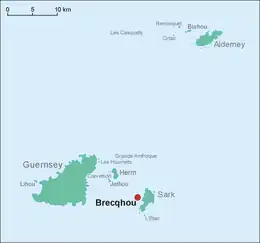 This is a map of the Bailiwick of Guernsey; Brecqhou is off the west coast of Sark | |
| Geography | |
|---|---|
| Coordinates | 49°25′56″N 02°23′17″W / 49.43222°N 2.38806°W |
| Archipelago | Channel Islands |
| Adjacent to | English Channel |
| Area | 74 acres (30 ha) |
| Administration | |
Bailiwick of Guernsey | |
| Jurisdiction | Sark |
| Demographics | |
| Population | 1 [1] |
Brecqhou (or Brechou; French pronunciation: [bʁɛku]) is one of the Channel Islands, located off the west coast of Sark where they are now geographically detached from each other. Brecqhou is politically part of both Sark and the Bailiwick of Guernsey. It has been established in the courts that Brecqhou is a tenement of Sark. The Ministry of Justice, the department of the United Kingdom government with responsibility for the Channel Islands,[2] considers Brecqhou part of Sark.[3]
Name
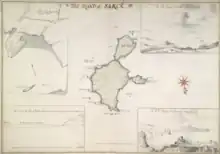
The name Brecqhou derives from the Old Norse brekka (slope or escarpment; compare Bricquebec) and holmr (island or islet; see -hou). It was also formerly known as "Merchant's Island" (L'Isle aux Marchands).[4][5] The spellings Brechou, Brehou, Brehoe appear on old maps.
Geography
A mere islet, Brecqhou has a surface area of just 74 acres (30 ha). The island is separated from Sark by an extremely narrow sound (Le Goulliot Passage) which can be perilous for rowers.[6] It is traversed frequently by yachts during each summer and by fishing boats year round and even forms a part of the route taken by occasional powerboating events in the islands.
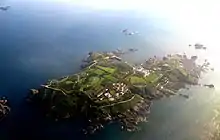 An aerial view of Brecqhou
An aerial view of Brecqhou A view of Brecqhou, from the north of Sark
A view of Brecqhou, from the north of Sark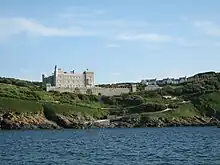 The Barclay Brothers' completed building the castle on Brecqhou in 1996.[7]
The Barclay Brothers' completed building the castle on Brecqhou in 1996.[7] A view of Brecqhou, from the south east
A view of Brecqhou, from the south east
Feudal relationship with Sark
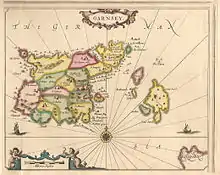
In Sark, the word tenant is used, and often pronounced as in French, in the sense of feudal landholder rather than the common English meaning of lessee. The landholdings of Sark are held by 40 tenants representing the parcels of the 40 families who colonised Sark. As explained on the Sark government website: "There is no true freehold, all land being held on perpetual lease (fief) from the Seigneur, and the 40 properties (Tenements) into which the Island is divided (as well as a few other holdings in perpetual fief) can only pass by strict rules of inheritance or by sale."[8] The relevance of the seigneurial privileges and duties that distinguish feudal from civil landowning has decreased as most of the duties relate to agriculture and defence.
Since 1929, the island has been connected to the title of the tenement La Moinerie de Haut, one of the 40 tenements whose owner had to keep a gun for the defence of the fief and, until forfeit in 2008, had a seat in the Chief Pleas. Originally, La Moinerie de Haut, named after the medieval monastery whose site is close to it, was a parcel of land in north west Sark that was, at that time, owned by the Seigneur himself. When Sibyl Hathaway sold the island of Brecqhou to Angelo Clarke in 1929, she transferred that seat in the Chief Pleas to unrepresented Brecqhou.[9] This was scant loss for her, as she owned more than one tenement and every member of the Chief Pleas was entitled to only one vote.
From 1993, the tenement of Brecqhou was owned by the Barclay brothers, the co-owners of The Daily Telegraph newspaper and former co-owners of The Scotsman. The brothers bought the island for £2.3 million in September 1993.[10] Under the Reform (Sark) Law 1951, the tenant was David Barclay. After assuming ownership, the brothers had intermittent legal disputes with the government of Sark, and expressed a desire to make Brecqhou politically independent. They drove cars on the island and had a helicopter, both of which are banned under Sark law.
- Customary and express written rule of Sark over Brecqhou may be evidenced in retention of all seigneurial rights per the sale instrument from the Dame (female Seigneur) of Sark, Hathaway, to Clarke in 1929.
- According to the Barclays this retention was invalid, as Brecqhou may not have been part of the fief of Sark. They cited facts such as that the letters patent establishing the fief do not mention the smaller island. While the Seigneur in long succession came to own Brecqhou (not before 1681), they cited practices and acts to suggest Brecqhou may not have been merged into the fief of Sark. Therefore the claim runs that the Seigneur could not legally hold the privileges valid elsewhere such as might survive sale, whatever its terms.
This conflict caused a lawsuit (1996–2000) and the founding in 2006 of a Brecqhou liaison sub-committee of Sark's Chief Pleas.
Sir David Barclay died in January 2021, leaving his brother as the sole tenant of Brecqhou.
Tenants
- 1929–1932: Angelo Clarke
- 1932–1944: Thomas Arthur Clarke (1871–1944; left the island 20 June 1940)
- 1949–1966: John Thomson Donaldson
- 1966–1987: Leonard Joseph Matchan
- 1987–1992: Susan Groves (not recognised by Seigneur of Sark)
- 1993–2021: David and Frederick Barclay
- 2021–: Sir Frederick Barclay
Flag and stamps
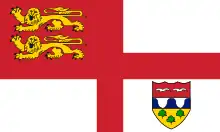
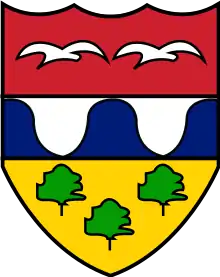
The former tenant, Leonard Joseph Matchan, had devised a personal flag (identical to the Sark flag, with the exception that the Matchan coat of arms was emblazoned on the bottom right). Although frequently considered the island flag, this was only a personal flag, and is no longer in use.[11]
The flag has since been adapted to equate with the current tenant, Sir Frederick Barclay. The current flag of Brecqhou remains in same format as the previous flag, but replacing the Matchan coat of arms with the twins' coats of arms in the bottom right.[11]
Leonard Joseph Matchan issued postage stamps (labelled "Brechou") on 30 September 1969, but they were suppressed the following day by the Guernsey Post Office when they took over responsibility from Royal Mail for the issue of stamps. Matchan occupied Brecqhou until his death on 6 October 1987. The current tenants issued stamps annually between 1999 and 2013.[12]
Public visits
In 2012, it was reported that the island is open to the public, by prior arrangement.[13]
Notes and references
- ↑ Island Brecqhou
- ↑ "Background briefing on the Crown dependencies: Jersey, Guernsey and the Isle of Man" (PDF). Ministry of Justice. Archived from the original (PDF) on 2 November 2019. Retrieved 21 November 2017.
- ↑ "International Covenant on Economic, Social and Cultural Rights – Fifth Periodic Report from the United Kingdom, the Crown Dependencies, the British Overseas Territories" (PDF). July 2007. Archived from the original (PDF) on 7 June 2009. Retrieved 1 February 2011.
- ↑ Quayle, Thomas (24 April 1815). General View of the Agriculture and Present State of the Islands on the Coast of Normandy, Subject to the Crown of Great Britain. London: Sherwood, Neely & Jones. p. 298 – via Google Books.
A small island, anciently called Brecqhou, now generally, l'Ile de Marchands, uninhabited, and used as a sheep-walk, lies on the west side.
- ↑ Suffling, Ernest Richard (7 February 2012) [1898]. "Chapter III". Jethou or Crusoe Life in the Channel Isles. Tredition. p. 39. ISBN 9783847209270 – via Google Books.
From the island, at the point opposite Neptune's Throne, a good view of Sark is obtained; on one day it will be seen standing clearly above the sea, with Brecqhou or Merchant's Island clearly discernable, and La Coupée (the isthmus which holds the two parts of the island together) plainly in view in the sunlight; on yet another day it will be quite invisible, although the distance is only about six miles.
- ↑ "A Week's Imprisonment in Sark". The Cornhill Magazine. 22: 537–550. October 1861 – via Google Books.
- ↑ Bowers, Simon; Pidd, Helen (27 June 2012). "Brecqhou: how windswept eyesore became Barclays' getaway". The Guardian.
- ↑ "Sark Chief Pleas". Isle of Sark Government.
- ↑ Ewen, Alfred Harry; de Carteret, Alan Roper (1969). The Fief of Sark. Guernsey: Guernsey Press. pp. 120–121.
In 1929 the seat in Chief Pleas held by the Tenant of la Moinerie de haut was transferred by La Dame to Mr. Angelo Clarke, who had purchased the Island of Brecqhou, and since that date it has been held by the owner of Brecqhou, who at the present time is Mr. Leonard Matchan.
- ↑ Pierce, Andrew; Frean, Alexandra; Binney, Marcus (7 October 1995). "Reclusive tycoons realise 30-year dream to buy Ritz". The Times.
- 1 2 Coutanche, André. "Brecqhou, Channel Islands". Flags of the World. Retrieved 21 April 2020.
- ↑ The Stamps of Brecqhou http://www.philatelicdatabase.com/topicals-thematics/the-stamps-of-brecqhou/ ; see also the Brecqhou Stamps website https://brecqhou-stamps.co.uk/
- ↑ Steele, Paul (8 May 2012). "Brecqhou: A private Channel Island opens to the public". Huffington Post. Retrieved 11 April 2012.
External links
- Lepelley, René (2001). Le dicotentin: 200 chroniques des mots d'ici et d'à côté [Le dicotentin: 200 stories of words from here and next door] (in French). Cherbourg: Isoète. ISBN 2-913920-06-3.
- Miller, Gertrude Mary, ed. (1971). BBC Pronouncing Dictionary of British Names. Oxford University Press.
- "Sark Islanders fear takeover". BBC Today Programme. 28 March 2012.
- Backman, Anders; Forrester, Bob (1981). The Postage Stamps of the Smaller Channel Islands. Channel Islands Publishing.
- "Welcome to the Brecqhou Stamps website". Brecqhou Development Ltd. 18 May 2020.